Electron microscopy Study guides, Revision notes & Summaries
Looking for the best study guides, study notes and summaries about Electron microscopy? On this page you'll find 946 study documents about Electron microscopy.
Page 4 out of 946 results
Sort by
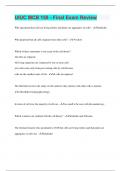
-
UIUC MCB 150 - Final Exam Review
- Exam (elaborations) • 353 pages • 2024
-
- £12.60
- + learn more
UIUC MCB 150 - Final Exam Review Who speculated that cells are living entities and plants are aggregates of cells? - Schleiden Who proposed that all cells originate from other cells? - Virchow Which of these statements is not a part of the cell theory? All cells are replaced All living organisms are composed of one or more cells new cells come only from pre-existing cells by cell division cells are the smallest units of life - all cells are replaced The field that involves the st...
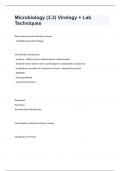
-
Microbiology (3.3) Virology + Lab Techniques 2024 passed
- Exam (elaborations) • 41 pages • 2024
- Available in package deal
-
- £16.26
- + learn more
Microbiology (3.3) Virology + Lab TechniquesDiverse Structure and Function of Viruses - classified by genetic homology Viral Infection and Diseases - virulence = ability of virus to induce disease in infected host - Avirulent strains replicate with no pathological or symptomatic consequence - no significant correlation b/t structure of viruses + diseases they induce! - DNA/RNA - Enveloped/Naked - Large/Small Genomes Brainpower Read More Overview viral infections (pic) V...
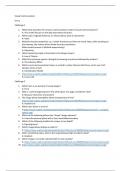
-
SOC 101 1001 Visual Communication Questions and Answers 2024
- Exam (elaborations) • 10 pages • 2024
-
- £8.53
- + learn more
Quiz 3 Part 1 of 8 - Chapter 3 18.0 Points Question 1 of 31 3.0 Points In an electron microscope, what type of cells are used? A. dead, processed cells B. live and fresh cells C. live, processed cells D. dead, but fresh cells Feedback:The processing and prep for electron microscopy kills the cells, and it is usually done in a vacuum. Review microscopy in Chapter 3. Question 2 of 31 3.0 Points Which is typically the most p
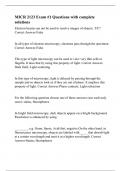
-
MICR 2123 Exam #1 Questions with complete solutions
- Exam (elaborations) • 5 pages • 2024
-
- £12.20
- + learn more
Electron beams can not be used to resolve images of objects. T/F? Correct Answer-False In all types of electron microscopy, electrons pass through the specimen. Correct Answer-False This type of light microscopy can be used to view very thin cells or flagella. It does that by using this property of light. Correct Answer-Dark field; Light scattering In this type of microscopy, light is delayed by passing through the sample and so objects look as if they are out of phase. It employs this ...
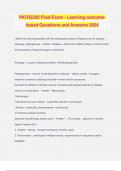
-
PATH2220 Final Exam - Learning outcome- based Questions and Answers 2024
- Exam (elaborations) • 95 pages • 2024
-
- £11.79
- + learn more
PATH2220 Final Exam - Learning outcome- based Questions and Answers 2024 define key terms associated with the pathological basis of disease such as disease, aetiology, pathogenesis - Answer- Disease = abnormal condition where normal function (homeostasis) of body part/organ is disturbed Aetiology = cause of disease/condition (inherited/acquired) Pathogenesis = manner of development of disease - cellular events / changes / reactions caused by aetiology that alter normal cellular processes ...
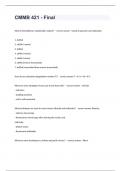
-
CMMB 421 - Final Question and answers 2024 verified to pass
- Exam (elaborations) • 16 pages • 2024
- Available in package deal
-
- £11.79
- + learn more
CMMB 421 - Final Question and answers 2024 verified to pass What is the Baltimore classification system? - correct answer - based on genome and replication 1. dsDNA 2. ssDNA (+sense) 3. dsRNA 4. ssRNA (+sense) 5. ssRNA (-sense) 6. ssRNA (reverse transcribed) 7. dsDNA (transcribed then reverse transcribed) How do you calculate triangulation number (T)? - correct answer T = h^2 + hk + k^2 What are some strategies viruses use to exit host cells? - correct answer - cell lysis ...
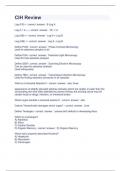
-
CIH Review Question and answers correctly solved 2023
- Exam (elaborations) • 45 pages • 2023
- Available in package deal
-
- £13.82
- + learn more
CIH Review Question and answers correctly solved 2023Log A^B = - correct answer B Log A Log A = X → - correct answer 10× = A Log (AB) = - correct answer Log A + Log B Log (A/B) = - correct answer Log A - Log B Define PCM - correct answer Phase Contrast Microscopy used for asbestos samples in air Define PLM - correct answer Polarized Light Microscopy Used for bulk asbestos analysis Define SEM - correct answer Scanning Electron Microscopy Can be used f...
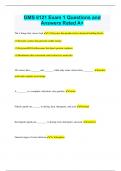
-
GMS 6121 Exam 1 Questions and Answers Rated A+
- Exam (elaborations) • 24 pages • 2024
- Available in package deal
-
- £8.13
- + learn more
GMS 6121 Exam 1 Questions and Answers Rated A+ The 4 things that viruses lack (1) Enzymes that produce basic chemical building blocks (2) Enzyme systems that generate usable energy (3) Enzymes/tRNAs/ribosomes that direct protein synthesis (4) Membranes that concentrate and localize key molecules All viruses have _______ and _______, while only some viruses have ________. nucleic acids and a capsid; an envelope A ________ is a complete, infectious virus particle. virion Naked c...
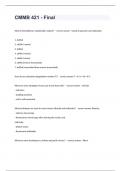
-
CMMB 421 - Final Questions with complete solution
- Exam (elaborations) • 16 pages • 2024
- Available in package deal
-
- £12.60
- + learn more
CMMB 421 - Final Questions with complete solution CMMB 421 - Final What is the Baltimore classification system? - correct answer - based on genome and replication 1. dsDNA 2. ssDNA (+sense) 3. dsRNA 4. ssRNA (+sense) 5. ssRNA (-sense) 6. ssRNA (reverse transcribed) 7. dsDNA (transcribed then reverse transcribed) How do you calculate triangulation number (T)? - correct answer T = h^2 + hk + k^2 What are some strategies viruses use to exit host cells? - correct answer - c...
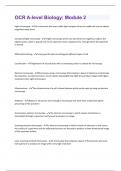
-
OCR A-level Biology: Module 2 | 156 Questions with 100% correct Answers | Verified
- Exam (elaborations) • 13 pages • 2023
- Available in package deal
-
- £5.28
- + learn more
Light microscope - An instrument that uses visible light and glass lenses to enable the user to objects magnified many times Compound light microscope - A light microscope which uses two lenses to magnify an object; the objective lens, which is placed near to the specimen and an eyepiece lens, through which the specimen is viewed Differential staining - Using specific stains to distinguish different types of cell Counterstain - Application of second stain with a contrasting colour to sampl...

How did he do that? By selling his revision notes on Stuvia. Try it yourself! Discover all about earning on Stuvia


